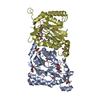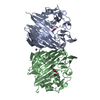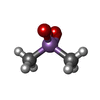+ Open data
Open data
- Basic information
Basic information
| Entry | Database: PDB / ID: 4h5u | ||||||
|---|---|---|---|---|---|---|---|
| Title | Structural insights into yeast Nit2: wild-type yeast Nit2 | ||||||
 Components Components | Probable hydrolase NIT2 | ||||||
 Keywords Keywords |  HYDROLASE / similar to mouse Nit2 / probable CN hydolase HYDROLASE / similar to mouse Nit2 / probable CN hydolase | ||||||
| Function / homology |  Function and homology information Function and homology informationdeaminated glutathione amidase / [acetyl-CoA carboxylase]-phosphatase activity / deaminated glutathione amidase activity / amide catabolic process /  mitochondrion mitochondrionSimilarity search - Function | ||||||
| Biological species |   Saccharomyces cerevisiae (brewer's yeast) Saccharomyces cerevisiae (brewer's yeast) | ||||||
| Method |  X-RAY DIFFRACTION / X-RAY DIFFRACTION /  SYNCHROTRON / SYNCHROTRON /  MOLECULAR REPLACEMENT / Resolution: 1.92 Å MOLECULAR REPLACEMENT / Resolution: 1.92 Å | ||||||
 Authors Authors | Liu, H. / Qiu, X. / Zhang, M. / Gao, Y. / Niu, L. / Teng, M. | ||||||
 Citation Citation |  Journal: Acta Crystallogr.,Sect.D / Year: 2013 Journal: Acta Crystallogr.,Sect.D / Year: 2013Title: Structures of enzyme-intermediate complexes of yeast Nit2: insights into its catalytic mechanism and different substrate specificity compared with mammalian Nit2 Authors: Liu, H. / Gao, Y. / Zhang, M. / Qiu, X. / Cooper, A.J.L. / Niu, L. / Teng, M. | ||||||
| History |
|
- Structure visualization
Structure visualization
| Structure viewer | Molecule:  Molmil Molmil Jmol/JSmol Jmol/JSmol |
|---|
- Downloads & links
Downloads & links
- Download
Download
| PDBx/mmCIF format |  4h5u.cif.gz 4h5u.cif.gz | 263.8 KB | Display |  PDBx/mmCIF format PDBx/mmCIF format |
|---|---|---|---|---|
| PDB format |  pdb4h5u.ent.gz pdb4h5u.ent.gz | 210 KB | Display |  PDB format PDB format |
| PDBx/mmJSON format |  4h5u.json.gz 4h5u.json.gz | Tree view |  PDBx/mmJSON format PDBx/mmJSON format | |
| Others |  Other downloads Other downloads |
-Validation report
| Arichive directory |  https://data.pdbj.org/pub/pdb/validation_reports/h5/4h5u https://data.pdbj.org/pub/pdb/validation_reports/h5/4h5u ftp://data.pdbj.org/pub/pdb/validation_reports/h5/4h5u ftp://data.pdbj.org/pub/pdb/validation_reports/h5/4h5u | HTTPS FTP |
|---|
-Related structure data
| Related structure data |  4hg3C  4hg5C  4hgdC  1emsS C: citing same article ( S: Starting model for refinement |
|---|---|
| Similar structure data |
- Links
Links
- Assembly
Assembly
| Deposited unit | 
| ||||||||
|---|---|---|---|---|---|---|---|---|---|
| 1 | 
| ||||||||
| 2 | 
| ||||||||
| Unit cell |
|
- Components
Components
| #1: Protein | Mass: 38413.789 Da / Num. of mol.: 4 Source method: isolated from a genetically manipulated source Source: (gene. exp.)   Saccharomyces cerevisiae (brewer's yeast) Saccharomyces cerevisiae (brewer's yeast)Strain: ATCC 204508 / S288c / Gene: J0706, NIT2, YJL126W / Production host:   Escherichia coli (E. coli) Escherichia coli (E. coli)References: UniProt: P47016,  Hydrolases; Acting on carbon-nitrogen bonds, other than peptide bonds Hydrolases; Acting on carbon-nitrogen bonds, other than peptide bonds#2: Chemical | ChemComp-GOL /  Glycerol Glycerol#3: Chemical | ChemComp-CAC / |  Cacodylic acid Cacodylic acid#4: Water | ChemComp-HOH / |  Water Water |
|---|
-Experimental details
-Experiment
| Experiment | Method:  X-RAY DIFFRACTION / Number of used crystals: 1 X-RAY DIFFRACTION / Number of used crystals: 1 |
|---|
- Sample preparation
Sample preparation
| Crystal | Density Matthews: 2.06 Å3/Da / Density % sol: 40.41 % |
|---|---|
Crystal grow | Temperature: 287 K / Method: vapor diffusion, hanging drop / pH: 6.5 Details: 17.5% PEG4000, 0.1M sodium cacodylate, pH 6.5, VAPOR DIFFUSION, HANGING DROP, temperature 287K |
-Data collection
| Diffraction | Mean temperature: 100 K |
|---|---|
| Diffraction source | Source:  SYNCHROTRON / Site: SYNCHROTRON / Site:  SSRF SSRF  / Beamline: BL17U / Wavelength: 0.97792 Å / Beamline: BL17U / Wavelength: 0.97792 Å |
| Detector | Type: RAYONIX MX-225 / Detector: CCD / Date: Mar 21, 2010 |
| Radiation | Monochromator: Si 111 CHANNEL / Protocol: SINGLE WAVELENGTH / Monochromatic (M) / Laue (L): M / Scattering type: x-ray |
| Radiation wavelength | Wavelength : 0.97792 Å / Relative weight: 1 : 0.97792 Å / Relative weight: 1 |
| Reflection | Resolution: 1.91→50 Å / Num. all: 95100 / Num. obs: 95100 / % possible obs: 100 % / Observed criterion σ(I): 4.66 |
| Reflection shell | Resolution: 1.91→1.94 Å / Redundancy: 3.7 % / Rmerge(I) obs: 0.348 / Mean I/σ(I) obs: 4.81 / Num. unique all: 4714 / % possible all: 100 |
- Processing
Processing
| Software |
| |||||||||||||||||||||||||||||||||||||||||||||||||||||||||||||||||
|---|---|---|---|---|---|---|---|---|---|---|---|---|---|---|---|---|---|---|---|---|---|---|---|---|---|---|---|---|---|---|---|---|---|---|---|---|---|---|---|---|---|---|---|---|---|---|---|---|---|---|---|---|---|---|---|---|---|---|---|---|---|---|---|---|---|---|
| Refinement | Method to determine structure : :  MOLECULAR REPLACEMENT MOLECULAR REPLACEMENTStarting model: 1EMS Resolution: 1.92→48 Å / Cor.coef. Fo:Fc: 0.95 / Cor.coef. Fo:Fc free: 0.933 / Cross valid method: THROUGHOUT / ESU R: 0.154 / ESU R Free: 0.134 / Stereochemistry target values: MAXIMUM LIKELIHOOD / Details: HYDROGENS HAVE BEEN ADDED IN THE RIDING POSITIONS
| |||||||||||||||||||||||||||||||||||||||||||||||||||||||||||||||||
| Solvent computation | Ion probe radii: 0.8 Å / Shrinkage radii: 0.8 Å / VDW probe radii: 1.4 Å / Solvent model: MASK | |||||||||||||||||||||||||||||||||||||||||||||||||||||||||||||||||
| Displacement parameters | Biso mean: 15.828 Å2
| |||||||||||||||||||||||||||||||||||||||||||||||||||||||||||||||||
| Refinement step | Cycle: LAST / Resolution: 1.92→48 Å
| |||||||||||||||||||||||||||||||||||||||||||||||||||||||||||||||||
| Refine LS restraints |
| |||||||||||||||||||||||||||||||||||||||||||||||||||||||||||||||||
| LS refinement shell | Resolution: 1.92→1.967 Å / Total num. of bins used: 20
|
 Movie
Movie Controller
Controller













 PDBj
PDBj








